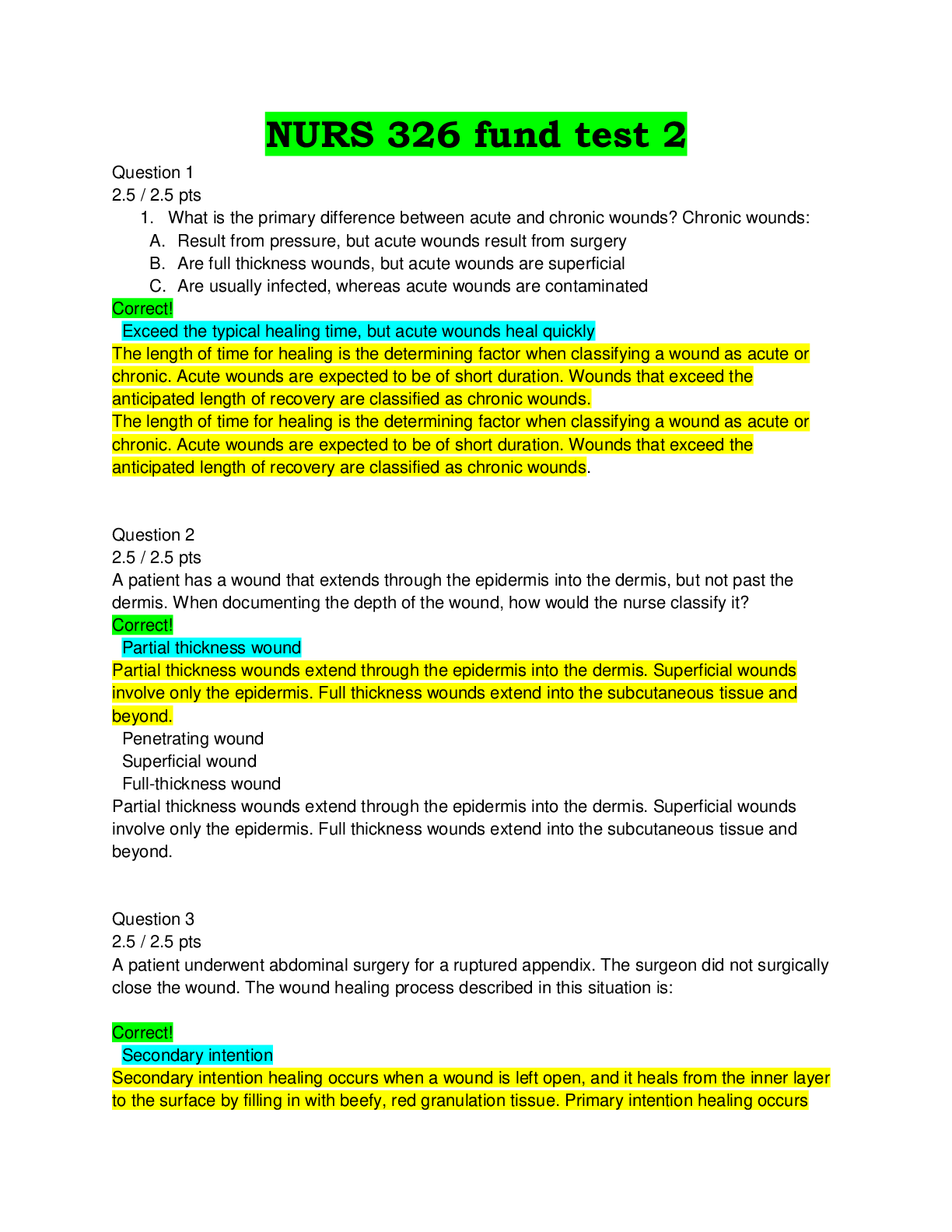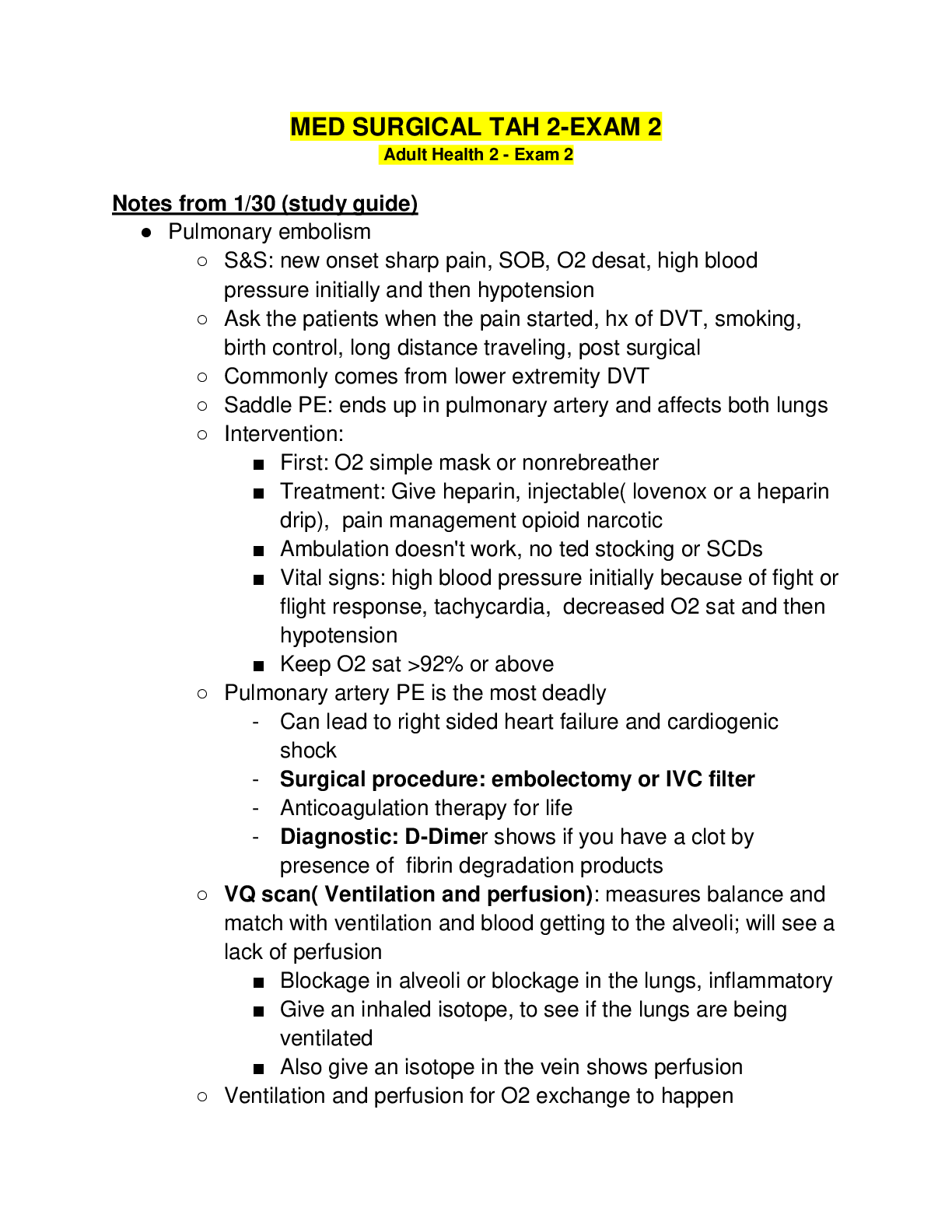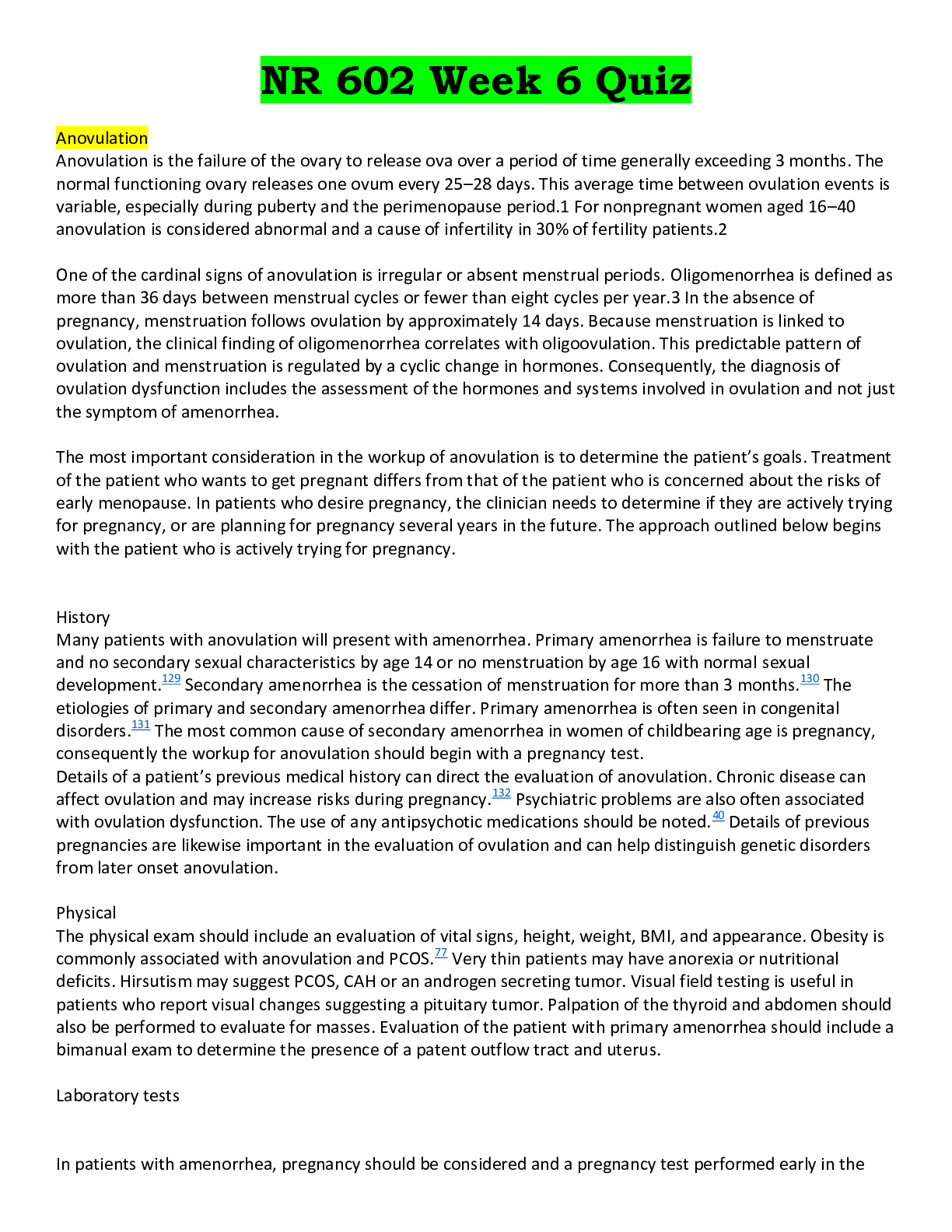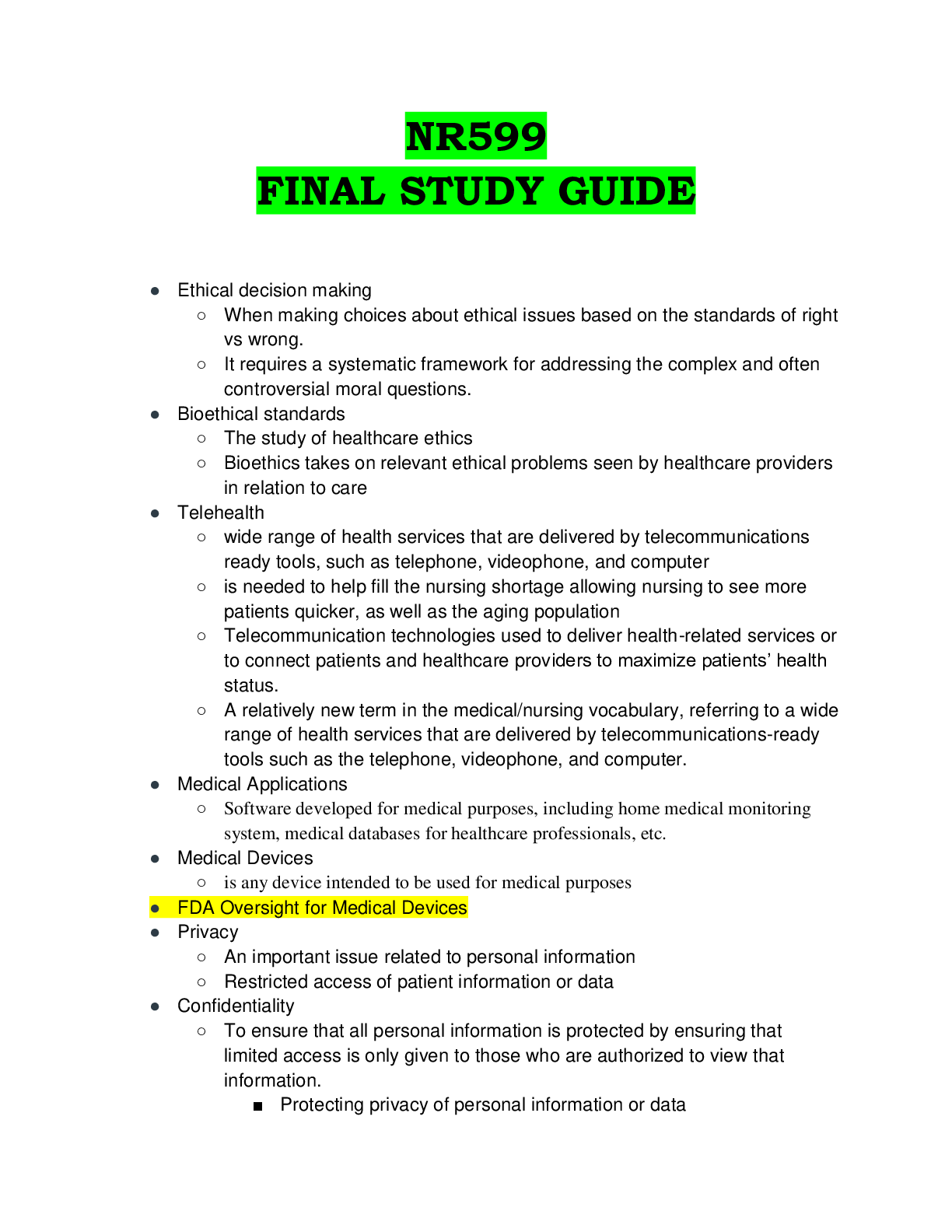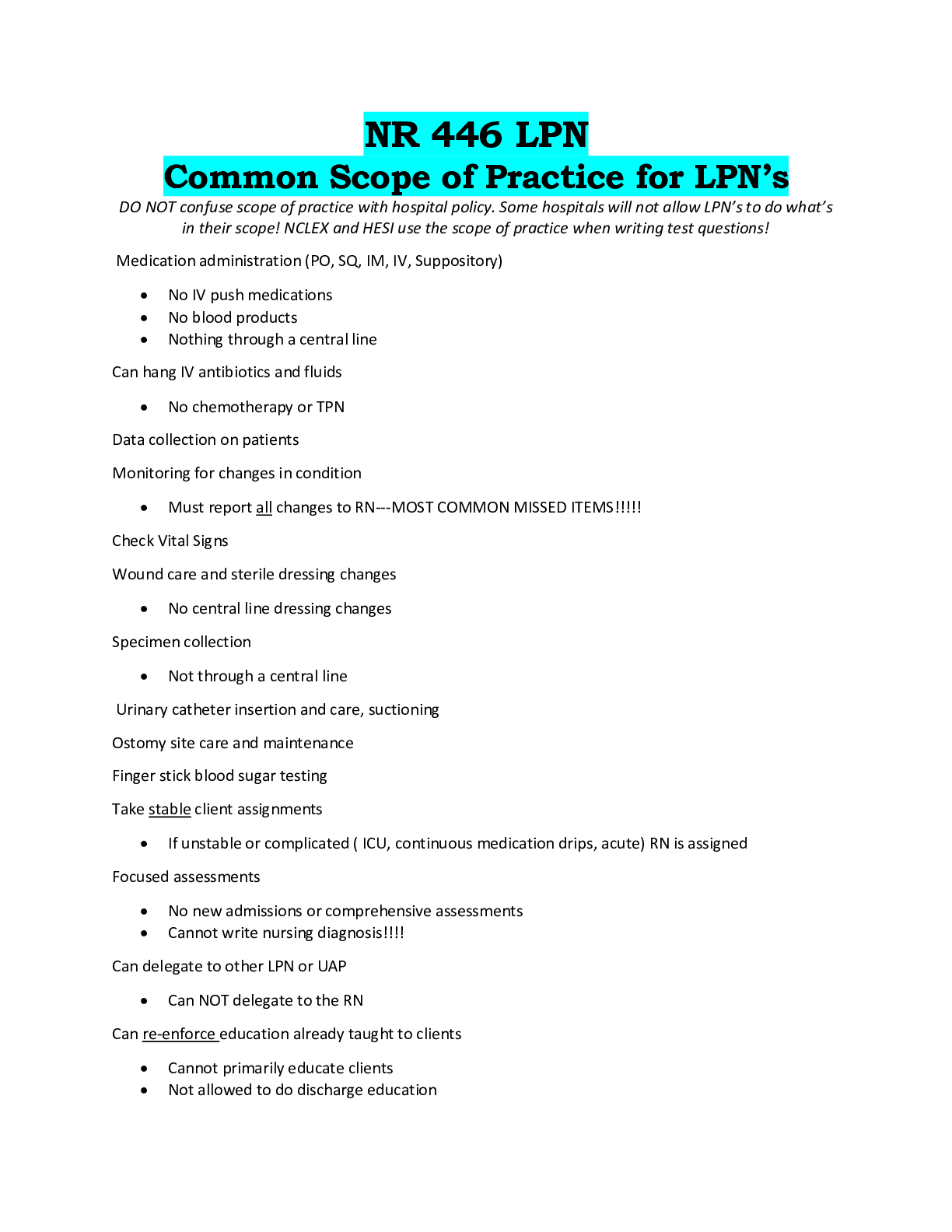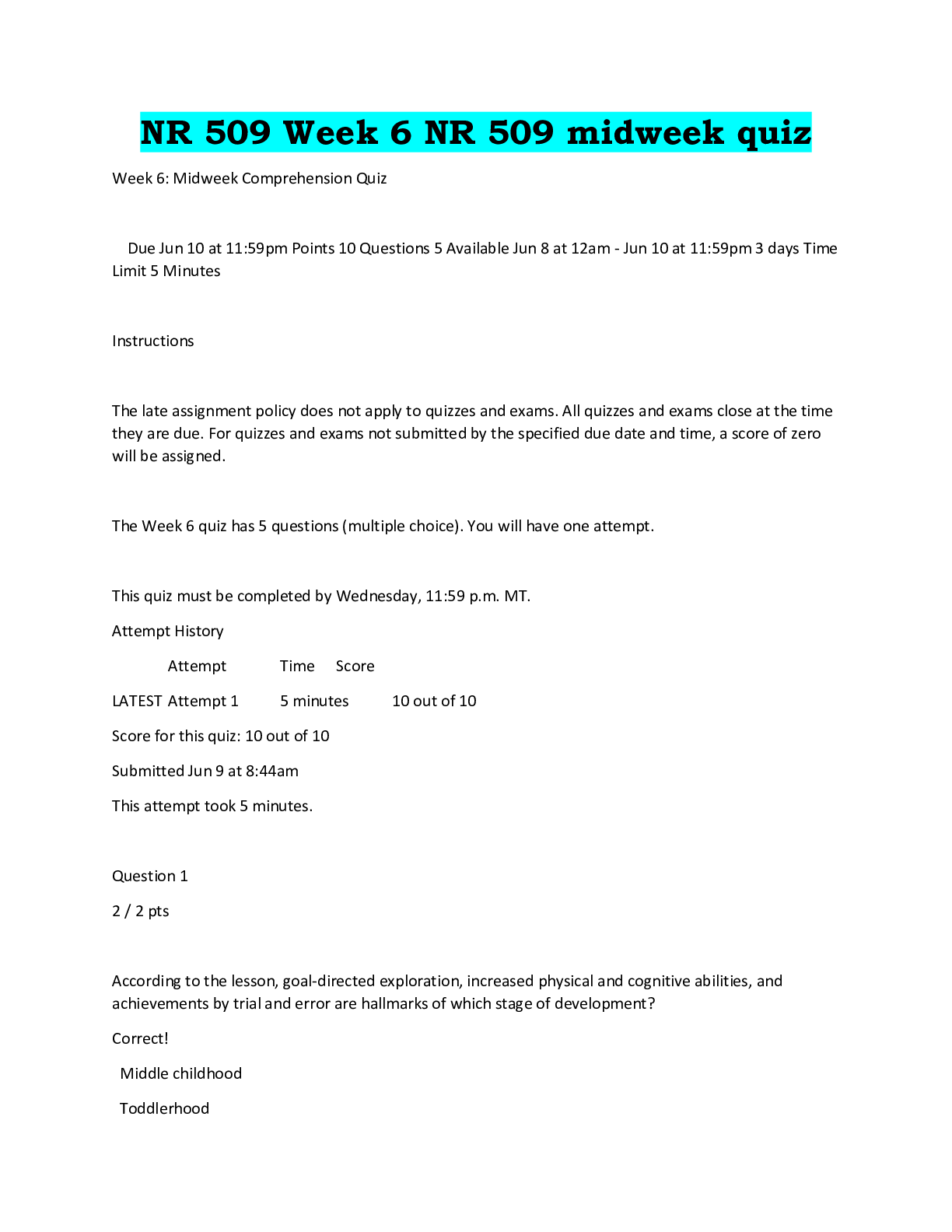Psychology > EXAM REVIEW > PSY 402, Cognitive Neuroscience Study Guide for Final Exam (All)
PSY 402, Cognitive Neuroscience Study Guide for Final Exam
Document Content and Description Below
PSY 402, Cognitive Neuroscience Study Guide for Final Exam Chapter 8: #1. Describe the function of effectors (distal and proximal), alpha motor neurons, gamma motor neurons, smooth muscles, striat... ed muscles, and spinal interneurons. - Alpha motor neurons: A motor unit consists of the extrafusal fibers innervated by a single alpha motor neuron. Alpha motor neurons: Alpha motor neurons in the spinal cord communicate with muscle fibers by releasing the neurotransmitter acetylcholine, which influences muscle activity by directly causing muscle contractions. An indirect way through which the brain modulates muscle tension is to alter the firing rate in the gamma motor system. The activity of the alpha motor neurons determines the strength of contraction of a muscle. n electromyogram (EMG) is recorded from electrodes placed on the skin over the muscle to measure electrical activity produced by the firing of alpha motor neurons. The input from the alpha motor neurons causes the muscle fibers to contract. Antagonist pairs of muscles span many of our joints. Activation of the triceps produces extension of the elbow; activation of the biceps produces flexion of the elbow - Gamma motor neurons: A key motor function of the reticular formation is to control muscle tone through the gamma motor system. The function of the gamma motor neuron is to control the sensitivity of the muscle spindle. - Smooth muscles: - Striated muscles: - Spinal interneurons: Relay and local interneurons are located within the CNS. 2. Describe the function of extrapyramidal tracts, the cerebellum (including vestibulo-, spino-, and neo-), and basal ganglia in helping us to move. Which part is most affected by alcohol intoxication? - The brain innervates the spinal cord via the pyramidal and extrapyramidal tracts. - Extrapyramidal tracts: The extrapyramidal tracts originate in various subcortical nuclei and terminate in both contralateral and ipsilateral regions of the spinal cord. the extrapyramidal tracts carry messages from subcortical structures to the spinal cord. - The cerebellum: The cerebellum sits below the posterior portion of the cerebral cortex. All cerebellar output originates in the deep cerebellar nuclei. Division of the Cerebellum --- Neocerbellum, Spinocerebellum, Vestibulocerebellum. Spinocerebellum results in trouble regulating performance Neocerebellum results in trouble planning motor movement Vestibullocerebellum results in trouble keeping the eyes on a visual object despite head or body movements and postural instability; may damage the eyeblink response.Lesions to two of the cerebellum’s three primary regions can lead to clumsy erratic movements and hypermetria. However, the first of these areas, the spinocerebellum, is involved primarily in regulating actual motor performance, whereas the second area, the neocerebellum, is involved primarily in the planning of movement. - Basal Ganglia- The inhibitory output of the basal ganglia keeps potential responses in check until activation for one of the options reaches a threshold, resulting in the initiation of that movement. By this model, “selection” occurs even though the basal ganglia need not evaluate the possible choices, but rather, only monitors their activation level. - Which part is most affected by alcohol intoxication? 3. Describe the cortical regions involved in motor control, including corticospinal tract, primary and secondary motor cortex, and association motor cortex. Include hemiplegia and apraxia (both ideomotor and ideational) in your answer. - Cortical Regions- All connections to the arms and legs originate in the spinal cord. The spinal signals are influenced by inputs from the brainstem and various cortical regions, whose activity in turn is modulated by the cerebellum and basal ganglia. Thus control is distributed across various levels of a control hierarchy. Sensory information from the muscles is transmitted back to the brainstem, cerebellum, and cortex. - Corticospinal Tract: The cells of origin of the corticospinal tract lie in the ipsilateral cerebral cortex. In contrast, the cells of origin of the lateral corticospinal tract lie in the contralateral cerebral cortex. Remember that the lateral corticospinal tract is the part of the corticospinal system in the spinal cord. Clinicians refer to the motor deficit resulting from a lesion of the corticospinal tract as hemiplegia (plegia means paralysis) or hemiparesis (weakness). -Primary Motor Cortex: Involved in Planning, Control, and Execution of Voluntary Movement. -Contains a somatic representation of the body -Corticospinal Pathway: originates in the cortex and terminates in the spinal cord -The primary outputs of the basal ganglia are to primary motor cortex and the ventromedial pathways.-The direct pathway between the basal ganglia and the motor cortex is excitatory for motor movement, whereas the overall effect of the indirect pathway through the internal globus pallidus (GPi) is inhibitory. - Secondary Motor Cortex: Secondary motor areas are involved with the planning and control of movement. One functional distinction be- tween premotor cortex and SMA is whether the action is externally or internally guided. - association motor cortex: a critical region for the representation of space. Supplementary Motor Cortex, Premotor Cortex, Posterior Parietal Include hemiplegia and apraxia (both ideomotor and ideational) - ideomotor apraxia, the patient appears to have a rough sense of the desired action but has problems executing it properly. - Ideational apraxia is much more severe. Here, the patient’s knowledge about the intent of an action is dis- rupted. 4. Describe the function of central pattern generators. - central pattern generators: Central pattern generators are neuronal circuits that when activated, can produce rhythmic motor patterns such as walking, breathing, flying, and swimming in the absence of sensory or descending inputs that carry specific timing information *Rhythmic patterns 5. Describe the concept of endpoint control, and the hierarchical nature of action sequences. - endpoint control reveals a fundamental capability of the motor control system, distance and trajectory planning demon- strate additional flexibility in the control processes. - hierarchical nature of action sequences 6. Describe how movements are neutrally coded (include center-out task, preferred direction, and population vector in your answer). center-out task: preferred direction: population vector: 7. Describe Cisek’s affordance competition hypothesis. 8. Describe the role of the supplementary motor area (SMA) and parietal motor areas (include alien hand syndrome and the repetition suppression effect in your answer). Single-cell recording studies have indicated that the supplementary motor area (SMC) may be especially important in the control of internally guided motor sequences, whereas the premotor cortex (PMC) may be especially important in the control of externally guided motor sequences9. Discuss the latest studies on brain-machine interface systems. 10. How do the basal ganglia serve as a “gatekeeper”? Include Huntington’s disease, Parkinson’s disease, hypokinesia, bradykinesia, OCD, Tourette’s Syndrome, and autism in your answer. 11. Describe how mirror neurons operate (include embodied cognition in your answer). 12. Describe how people learn and perform new skills (include sensorimotor adaptation, prism adaptation, visuomotor tasks, forward models, and expertise in your answer). Chapter 9: 13. Distinguish the different types of memory: sensory, short-term, working and long-term (include declarative, episodic, semantic, nondeclarative, and procedural memory, as well as classical conditioning, priming, and habituation in your answer). (Hint: see Figure 9.2, p. 381.) Sensory- 14. Where in the brain are those types of memories located? (Hint: see Figure 9.41, p. 421). 15. Define encoding, acquisition, consolidation, storage, and retrieval, as they pertain to memories. 16. Distinguish between anterograde and retrograde amnesia (include Ribot’s Law). 17. Distinguish between proactive and retroactive interference. 18. Discuss the four components of Baddeley and Hitch’s model of working memory. 19. How does the medial temporal learning affect learning and memory (include hippocampus, amnygdala, delayed nonmatc-to-sample task, and contextual fear learning). 20. Distinguish the function of the perirhinal cortex with the posterior part of the parahippocampal cortex. 21. How does memory consolidation take place? Contrast the standard consolidation theory with multiple trace theory. 22. Describe how Hebbian learning takes place (include long-term potentiation, cooperativity, associativity, and specificity in your answer). Chapter 10: 23. Describe Plutchik’s eight basic categories of emotion. Distinguish complex emotions from basic ones. 24. What are the three components of an emotion? 25. Describe how the following parts of the brain play a role in emotions: limbic system, Papez circuit, amygdala, orbitofrontal cortex, insular cortex, hypothalamus, and anterior cingulate cortex.26. Describe the differences among the following theories of emotion: James-Lange, Cannon-Bard, Singer-Schachter, Lazarus, constructivist approach, evolutionary approach, and LeDoux. 27. What is Kluver-Bucy Syndrome? 28. Describe the difference between implicit and explicit emotional learning. 29. How do the amygdala and the hippocampus affect each other? 30. How does the orbitofrontal cortex affect decision-making, regret, and counterfactual thinking? 31. What is the purpose of the Implicit Association Test? 32. Contrast antecedent-focused and response-focused emotion regulation in Gross’s model. 33. How does the insular cortex affect affective processing? (Include interoception, disgust, happiness, and love in your answer.) Chapter 11: 34. Define anomia, TOTP (or TOT), dysarthria, alexia, apraxia, and aphasia. 35. Discuss the differences among Broca’s aphasia, Wernicke’s aphasia, and conduction aphasia. 36. Define mental lexicon, phoneme (and phonology), morpheme (and morphology), semantics, syntax, grammar, pragmatics, prosody, lemma, and lexeme. 37. Contrast the N400 with the P560 and P600 responses. 38. What are the differences in these models used to explain word comprehension: modular, interactive, and hybrid? 39. Describe the three steps of Hagoort’s language model. 40. Describe the differences between macroplanning and microplanning in Levelt’s model. 41. Describe the functions pf the ventral and dorsal pathways in Friederici’s model. 42. Define displacement and infinite generativity. Chapter 12: 43. Define cognitive control, and distinguish it from goal-oriented behavior. 44. How do the LPFC, FP, OFC, and the MFC affect cognitive control? 45. Define utilization behavior, action-outcome expectancy, habit, and perseveration. 46. What is the difference between crystallized and fluid intelligence? 47. Define object permanence (include the AB search error in your answer). 48. Describe how these axes affect PFC function: ventral-dorsal gradient, anteriorposterior gradient, and lateral-medial gradient. 49. Describe the difference between a heuristic and an algorithm. 50. Describe the difference between primary and secondary reinforcers. 51. How does functional fixedness impair creativity and problem-solving? 52. Describe the difference between convergent and divergent thinking. 53. Describe the steps of an action hierarchy. 54. Explain substance abuse as a loss of inhibitory control. Chapter 13:55. Explain how the following parts of the brain play a role in affecting social cognition: PFC, DLPFC, VLPFC, OFC, PCC, ACC, autonomic nervous system, hypothalamicpituitary-adrenal pathway, TPJ, FFA, STS, and medial parietal cortex. (!) 56. Explain the origins and symptoms of autism (mindblindness), ASD, and schizophrenia. 57. How does the MPFC affect self-referential processing? 58. Define default network and the sentinel hypothesis. 59. Describe the “abject failings of the lobotomy craze” (p. 565). 60. Define Theory of Mind, empathic accuracy, Simulation Theory, Theory Theory, and schadenfreude. 61. Describe how the right TPJ affects the FFA and the False-Belief Task. 62. What are some brain abnormalities found in those diagnosed with ASD? 63. Explain differences in how those with ASD and those without ASD function with regard to making inferences (include eye-gazing, imitation, and the grasping experiment in your answer). 64. Define reversal learning, neuroeconomics, neuroethics, and APD. Chapter 14: 65. Define core consciousness, extended consciousness, and connection loops. 66. Distinguish dualism from monism/ materialism/ idea-ism/ idealism. 67. How is consciousness related to self-knowledge, access to information, and sentience (qualia)? 68. How do blindsight, subliminal perception, priming, “scaffolding the storage,” and the backward referral hypothesis provide evidence of the unconscious? 69. What are the differences between left and right hemispheric concepts related to consciousness? 70. Use mirror self-recognition (MSR), imitation, and Theory of Mind to discuss whether some primates have a sense of consciousness. 71. Use determinism, chaos theory, quantum theory, emergence, and multiple realizability to discuss whether free will exists (include “weak emergence,” “strong emergence,” and personal responsibility in your answer). 72. Discuss the differences among the reasons for capital punishment (deterrence, retribution, and incapacitation). 73. Discuss the differences among retributive, utilitarian, and restorative justice. 74. Discuss how the problem of free riders can be dealt with in a cooperative society (include the emotional reactivity hypothesis in your answer). [Show More]
Last updated: 1 year ago
Preview 1 out of 6 pages
Instant download

Buy this document to get the full access instantly
Instant Download Access after purchase
Add to cartInstant download
Reviews( 0 )
Document information
Connected school, study & course
About the document
Uploaded On
May 15, 2021
Number of pages
6
Written in
Additional information
This document has been written for:
Uploaded
May 15, 2021
Downloads
0
Views
49

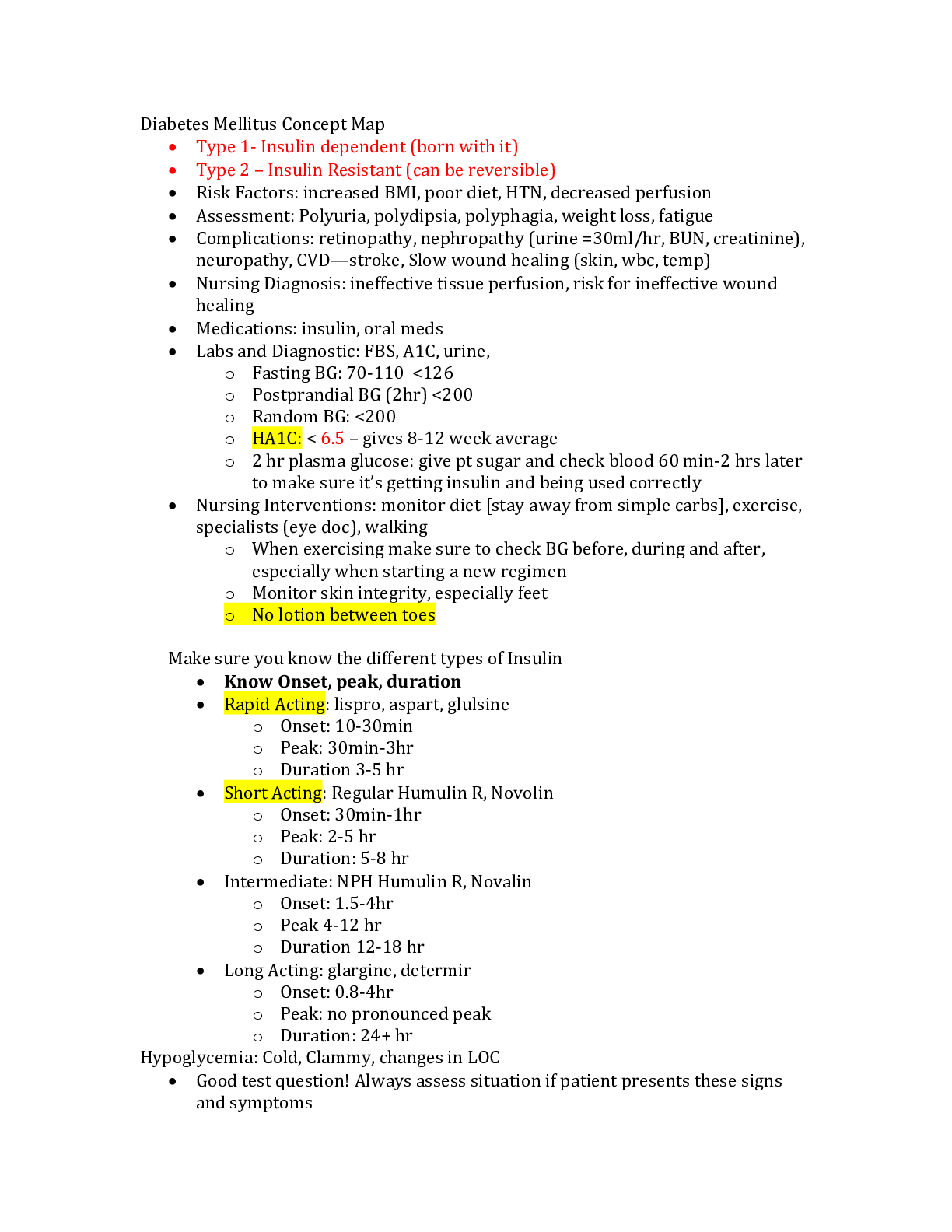
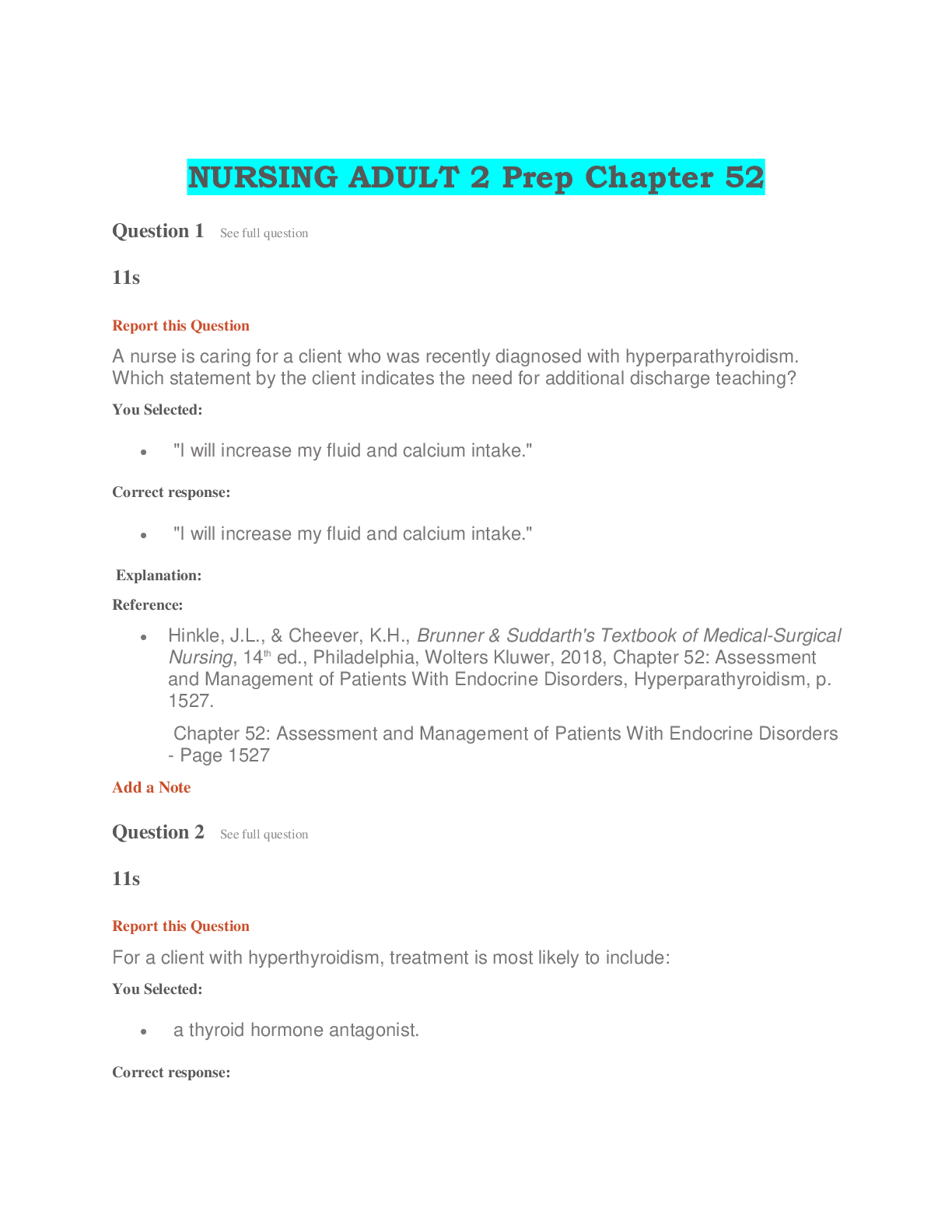
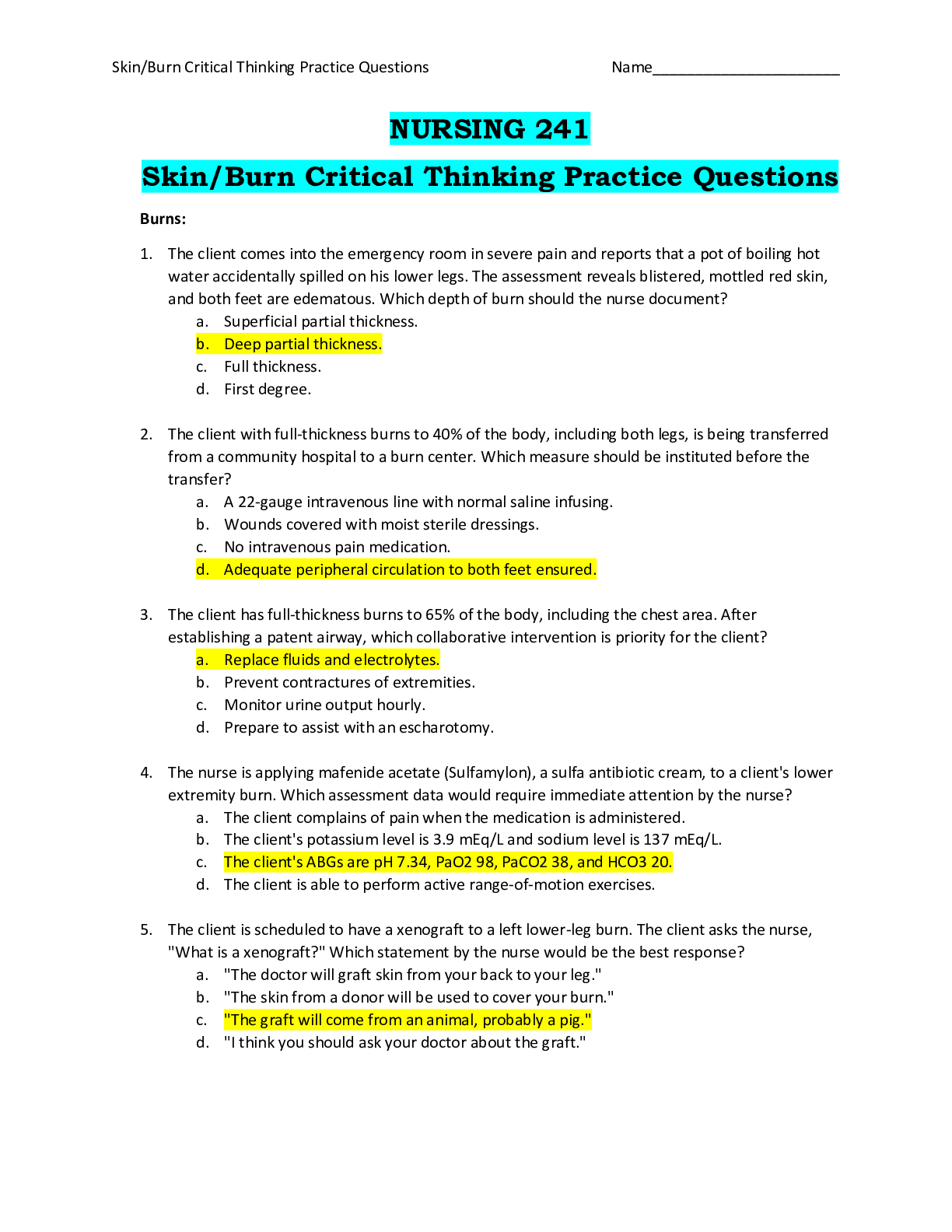
.png)
